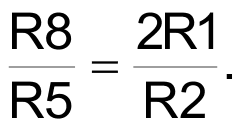Frequent design idea contributor, Peter Demchenko, recently published “Extending the resolution of a peripheral DAC” (Reference 1). In it, Peter describes an inverting dual-supply amplifier circuit that he says is intended “…to improve the resolution of a peripheral DAC. The circuit also reduces output resistance of the DAC and can reduce its offset.”
The circuit presented here (see the Figure 1) takes a somewhat different approach to a similar goal. It employs a single supply, non-inverting topology optimized for parameters (e.g., output offset and reference voltages) that are more accurately typical of actual microcontroller DAC specs (e.g., from the tinyAVR® 1-series Table 36-31: DAC offset error = -40 mV to +20 mV).
 |
|
| Figure 1. | RRIO noninverting op-amp needs only one supply-voltage polarity to tailor DAC output. |
R1, R2, R5, and R8 provide DAC offset adjustment:


R3 and R4 provide DAC span adjustment: R4/R3 = 1 for a 2:1 span adjustment range
R6 extends DAC resolution* to 9 bits via general purpose bit DIOa:

R7 extends DAC resolution* to 10 bits via DIOb:

Although the signal levels used here to calculate resistor values (e.g., 4.3 V DAC output span and 40 mV DAC offset) are specific to the tinyAVR® 1-series, similar parameters will apply to other combinations of microcontroller and on-chip analog peripherals, making the circuit easy to translate to different contexts.
*) Note that sadly, resolution and monotonicity are not necessarily the same thing. DNL rules!
Reference
- Demchenko, Peter, "Extending the resolution of a peripheral DAC."